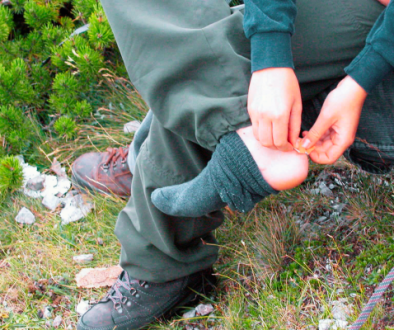Group Hiking – The Amazing Social and Health Benefits
Have you ever noticed how a conversation flows more naturally when you’re walking side by side rather than sitting face to face? There’s something amazing about moving through nature together that breaks down barriers and opens up connections in ways that few other activities can. As someone who’s discovered the joy of group hiking relatively late in life, I can tell you that hitting the trails with others has transformed not just my physical health, but my entire social landscape and mental wellbeing.
In this post, I’ll share the research-backed benefits of group hiking and why it might be exactly what you need if you’re looking to improve your health, expand your social circle, or simply find a more meaningful way to spend your weekends.
Group Hiking Physical Health Benefits: More Than Just Exercise
Group hiking is a powerhouse for physical health, offering benefits that extend far beyond what you might expect from a leisure activity.
Impressive Health Improvements Without Extreme Effort
According to a comprehensive analysis published in the British Journal of Sports Medicine, participating in outdoor walking groups leads to significant improvements in several key health indicators. These include reductions in blood pressure, resting heart rate, and total cholesterol, as well as improvements in body weight, body fat, and overall physical functioning.
What’s particularly encouraging is that these benefits emerge even when walking groups don’t fully meet international guidelines for moderate activity. This supports the important principle that any physical activity is better than none – you don’t have to be scaling mountains to reap the rewards!
Consistency: The Secret to Long-Term Health
One of the most valuable aspects of group hiking is the consistency it promotes. Studies show that walking group participants demonstrate remarkable adherence to exercise regimens, maintaining their habits rather than abandoning them over time, something that can’t be said for many other forms of exercise.
This consistency is crucial for long-term health benefits, as regular physical activity is strongly associated with reduced risk of chronic diseases. I’ve experienced this first hand, knowing that my hiking group has kept me active through seasons when I’d otherwise have hibernated on my couch!
Safety Profile: Low Risk, High Reward
Group hiking also has a strong safety profile. While some participants occasionally experience adverse effects (primarily limited to falls), these are relatively rare. This favorable risk-benefit ratio makes group hiking an accessible option for many individuals seeking to improve their physical health without risking injury.
Mental Health and Psychological Benefits: Nature’s Therapy Session
The mental health benefits of group hiking are equally impressive and, in my experience, often the most immediately noticeable. Related Post.
Nature’s Antidepressant Effect
Research from Stanford University indicates that spending time hiking in natural environments reduces stress, calms anxiety, and is associated with a lower risk of depression. The combination of physical activity, exposure to nature, and social connection creates a powerful intervention for mental wellbeing.
Many organizations have recognized this powerful effect, developing programs specifically targeting mental wellbeing through group hiking. For example, the Mental Health & Wellbeing Hiking Group incorporates weekly mental health topics alongside hiking activities, combining the inherent benefits of nature exposure with focused psychological support.
Organizations like Beyond Blue have created hiking events specifically designed to support mental health, recognizing the powerful combination of exercise, nature, and community. Related Post.
Group Hiking The Magic of Open Conversations on the Trail
There’s something about walking side by side, rather than face to face, that seems to open up conversation in remarkable ways. I’ve noticed that both myself and others tend to have more open, genuine conversations while hiking than we do in other social settings. Something about the rhythm of walking, the absence of screens and other distractions, and the calming effect of nature creates a space where people feel safe to share more deeply.
A friend in my hiking group once mentioned that she’d had more meaningful conversations in hikes than in years of office small talk. I’ve found the same to be true, something about the trail creates a unique space for authentic connection.
Building Resilience Through Shared Challenges
Group hiking also provides a buffer against psychological challenges by creating a supportive environment. Research on thru-hiking experiences (hiking an entire trail in a continuous journey) has shown that social relationships significantly contribute to hikers’ ability to cope with challenges encountered during their treks.
This suggests that the social element of group hiking enhances resilience and psychological coping mechanisms, skills that transfer well beyond the trail.
Motivation and Perception Benefits: Making the Impossible Seem Possible
One of the most fascinating aspects of group hiking is how it changes our perception of challenges and boosts our motivation.
The Power of Shared Perception
A fascinating study from the University of Virginia found that college students perceived hills as less steep and challenging when they were with others compared to when they stood alone. This altered perception demonstrates how the social aspect of group hiking can make physical challenges seem more manageable, potentially increasing participants’ willingness to attempt more challenging trails or longer distances.
I’ve experienced this firsthand. Trails that I would have considered too difficult on my own suddenly seem achievable when I’m with my hiking group. The presence of supportive companions seems to literally change how we perceive the challenges before us.
Accountability and Encouragement: When Your Motivation Wanes
Group hiking provides accountability and motivation that’s difficult to maintain when hiking solo. Knowing others expect you to participate creates a sense of commitment that helps overcome individual motivation lapses. When personal motivation wanes, encouragement from group members can help individuals persevere and maintain their hiking practice.
As Cotswold Outdoor notes, this mutual encouragement often makes the difference between staying consistent and giving up when weather or life challenges arise.
Social Connection and Community Building: Finding Your Tribe
Perhaps the most distinctive benefit of group hiking compared to solo hiking is the opportunity for meaningful social connection. In our increasingly digital world, face-to-face interaction has become less common, making group hiking a valuable opportunity for genuine human connection.
Building Connections Across Diverse Groups
Group hiking facilitates connections across diverse participants. Members of hiking clubs report forming friendships with people of different age groups whom they might not otherwise engage with easily. These cross generational connections expand social networks and expose individuals to diverse perspectives and experiences.
The Keystone Trails Association highlights how hiking clubs bring together people from various backgrounds who share a common interest in nature, creating unique opportunities for cross demographic connections.
Finding Like-Minded Individuals
Beyond strengthening existing relationships, group hiking creates opportunities to form new connections with like-minded individuals. Many hikers report meeting friends through hiking groups, often leading to long-lasting friendships. These connections are built on shared experiences and challenges, creating bonds that frequently extend beyond hiking activities.
I’ve found that the people I meet through hiking tend to share certain values, an appreciation for nature, an interest in active lifestyles, and often a thoughtfulness about life that’s refreshing. There’s something about finding others who choose to spend their free time in similar ways that creates an immediate point of connection.
Enhancing Existing Relationships
Research suggests that time spent together in natural environments actually improves the quality of relationships. A study titled “The Effects of the Natural Environment on Attention and Family Cohesion” found that even short periods of time spent together in natural settings enhanced family cohesion. This indicates that group hiking may be particularly effective at strengthening existing relationships.
I’ve noticed this effect when hiking with old friends our conversations tend to go deeper, and the shared experience of completing a challenging trail together creates lasting memories that strengthen our bond.
Practical Benefits of Hiking with Others: Safety, Knowledge, and Discovery
Group hiking offers several practical advantages beyond health and social benefits.
Safety in Numbers
Safety is a significant concern for many outdoor enthusiasts, particularly those who might feel vulnerable hiking alone. Female hikers specifically mention safety as a major benefit of group hiking, noting that group participation alleviates concerns about being alone on trails.
This safety benefit cannot be overstated, it opens up hiking opportunities to many who would otherwise feel uncomfortable venturing out on trails alone.
Knowledge Sharing and Skill Development
Knowledge sharing represents another practical benefit of group hiking. Experienced hikers share valuable information about trail conditions, hiking gear, identification of flora and fauna, and proper hiking techniques. This collective knowledge enhances the hiking experience and helps newer hikers develop skills and confidence more quickly than they might through solo experiences.
When I first started hiking with a group, I was amazed at how much I learned from more experienced members – from proper layering techniques to identifying local plants and birds. This knowledge sharing is part of what makes the hiking community so special.
Discovering New Trails and Environments
Group hiking also exposes participants to new environments they might not discover independently. People frequently report learning about different and new trails through their group hiking experiences. This exposure to varied environments enhances the hiking experience and prevents the boredom that can sometimes accompany repeatedly visiting the same locations.
Comparing Solo vs. Group Hiking Benefits
While both solo and group hiking offer tremendous benefits, they each have distinct advantages. Here’s a comparison to help you decide which might be right for you at different times:
| Aspect | Solo Hiking | Group Hiking |
| Physical Health | Great exercise and fitness benefits | Similar physical benefits plus higher consistency due to accountability |
| Mental Health | Solitude, reflection, and mindfulness | Stress reduction plus social support and resilience building |
| Safety | Increased risk, especially in remote areas | Enhanced safety through numbers and shared knowledge |
| Learning | Self-discovery and self-reliance | Knowledge sharing and faster skill development |
| Social Benefits | Limited to self-reflection | Community building and relationship development |
| Flexibility | Complete control over pace and schedule | Compromise required on routes and timing |
| Trail Discovery | Limited to personal research | Exposure to new trails through collective knowledge |
As this comparison shows, group hiking offers unique benefits that solo hiking simply cannot provide, particularly in the areas of social connection, safety, and knowledge sharing.
Getting Started with Group Hiking: Tips for Beginners
If you’re new to hiking or have primarily hiked solo, here are some tips for finding and joining a hiking group: Related Post.
Finding the Right Hiking Group
- Check local outdoor retailers – Many have bulletin boards or host their own group hikes
- Search social media – Facebook groups and Meetup.com are great places to find local hiking groups
- Contact conservation organizations – Many host regular hikes to build support for their work
- Visit your local parks department website – Some offer guided hikes and outdoor programs
Making the Most of Your Group Hiking Experience
- Start with beginner-friendly hikes to build confidence and endurance
- Be open to conversation but also respect others who may prefer quiet time
- Share your knowledge but avoid dominating discussions
- Respect group pace – hiking groups typically move at the pace of the slowest member
- Prepare properly by bringing adequate water, snacks, and appropriate clothing
Conclusion: The Trail to Better Health and Richer Connections
Group hiking offers a remarkably comprehensive package of benefits spanning physical health, mental wellbeing, and social connection. The physical benefits include improvements in cardiovascular measures, weight management, and physical functioning. Mental health advantages encompass stress reduction, anxiety management, and decreased depression risk. Socially, group hiking facilitates meaningful connections, strengthens existing relationships, and builds supportive communities.
These benefits are mutually reinforcing, the social aspects enhance motivation and consistency, leading to greater physical benefits, while the combined physical activity and nature exposure creates a uniquely effective environment for building relationships.
As Hikezilla notes, being part of a hiking community creates positive impacts that extend far beyond the trails themselves, influencing how we approach challenges, relationships, and wellbeing in our everyday lives.
For those seeking a holistic approach to wellbeing that addresses physical, mental, and social health simultaneously, group hiking offers an accessible and evidence-supported option. As society continues to grapple with physical inactivity, mental health challenges, and social isolation, group hiking represents a powerful intervention that addresses all these issues simultaneously.
So lace up your boots, find a group, and hit the trails – your body, mind, and social circle will thank you!




